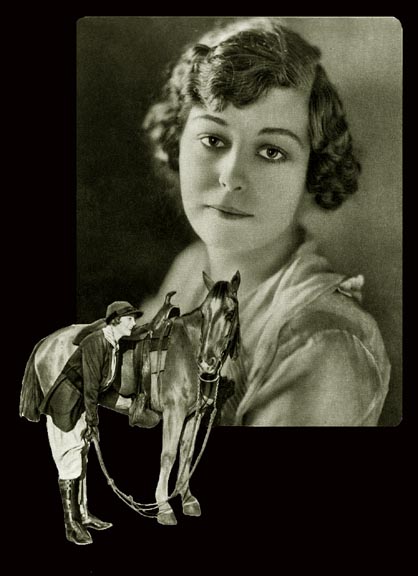"silent movies" "silent
film" "silent era"
 Seena Owen
Seena Owen was born Signe Auen in Spokane, Wash., in
1894. She performed on stage with the Alcazar Stock Company in
San Francisco, but entered the movies with the Kalem Company in
1914. She later joined D.W. Griffith, but almost wasn't hired.
Griffith was put off by her "cool composure" and told
her she was too unemotional to be an actress. She resonded, "Then
I'm an actress, because I'm trembling inside." He hired her
on the spot. It was Griffith who changed her name to Seena Owen
because he couldn't pronounce her real name. In her first year
after being hired by Griffith, she appeared with Dorothy Gish
in "Bred in the Bone" (1915), with Wallace Reid in "A
Yankee from the West" (1915), with Douglas Fairbanks in "The
Lamb" (1915), and starred in the Majestic feature "The
Fox Woman" (1915) which was directed by Lloyd Ingraham. The
next year, she was seen in the role for which she is most remembered,
the Princess Beloved in Griffith's epic masterpiece "Intolerance"
(1916). This was also when she met actor George Walsh, and they
were married in 1916. The couple divorced in 1924 although they
had separated several years before. She appeared in over 60 movies
between 1914 and 1933, none of them very remarkable although she
did co-star with William S. Hart in "Breed of Men" (1919),
Jack Holt and Lon Chaney in "Victory" (1919), "Rush
Hour" (1928) with Marie Prevost, and "Queen Kelly"
(1929) with Gloria Swanson. Each of these films survives today.
Owen's last film appearance also survives - "Officer 13,"
a 1933 low-budget sound film that also includes former silent
stars Monte Blue and Lila Lee. After her retirement from films,
Owen began a very successful career as a screenwriter with such
films as "Rumba" (1935) with George Raft and Carole
Lombard, "The Thrill of a Lifetime" (1937) with Betty
Grable, "Aloma of the South Seas" (1941) with Dorothy
Lamour, and "The Great Man's Lady" (1942) with Barbara
Stanwyck to her credit. Several former colleagues have commented
on Owen's beauty in their autobiographies: Griffith camerman Billy
Bitzer said, "Seena was a truly beautiful girl who needed
no help from the camera." Karl Brown, who was an assistant
cameraman under Griffith and went on to be one of the top cameramen
of the silent era, said Owen's "lush beauty had made earlier
pictures the success upon which Griffith's reputation rested.
. ." Miriam Cooper, who is best remembered as Margaret Cameron
in "The Birth of a Nation" (1915), called her "a
beautiful Swedish girl" with whom she was very close during
the making of "Intolerance." Owen died in Hollywood
in 1966.
Selected films of this star available for viewing:
The Lamb
(1915)
Intolerance (1916)
Branding Broadway (1918)
Victory
(1919)
Rush Hour (1928)
Queen Kelly (1929)
Seena Owen
Seena Owen was born Signe Auen in Spokane, Wash., in
1894. She performed on stage with the Alcazar Stock Company in
San Francisco, but entered the movies with the Kalem Company in
1914. She later joined D.W. Griffith, but almost wasn't hired.
Griffith was put off by her "cool composure" and told
her she was too unemotional to be an actress. She resonded, "Then
I'm an actress, because I'm trembling inside." He hired her
on the spot. It was Griffith who changed her name to Seena Owen
because he couldn't pronounce her real name. In her first year
after being hired by Griffith, she appeared with Dorothy Gish
in "Bred in the Bone" (1915), with Wallace Reid in "A
Yankee from the West" (1915), with Douglas Fairbanks in "The
Lamb" (1915), and starred in the Majestic feature "The
Fox Woman" (1915) which was directed by Lloyd Ingraham. The
next year, she was seen in the role for which she is most remembered,
the Princess Beloved in Griffith's epic masterpiece "Intolerance"
(1916). This was also when she met actor George Walsh, and they
were married in 1916. The couple divorced in 1924 although they
had separated several years before. She appeared in over 60 movies
between 1914 and 1933, none of them very remarkable although she
did co-star with William S. Hart in "Breed of Men" (1919),
Jack Holt and Lon Chaney in "Victory" (1919), "Rush
Hour" (1928) with Marie Prevost, and "Queen Kelly"
(1929) with Gloria Swanson. Each of these films survives today.
Owen's last film appearance also survives - "Officer 13,"
a 1933 low-budget sound film that also includes former silent
stars Monte Blue and Lila Lee. After her retirement from films,
Owen began a very successful career as a screenwriter with such
films as "Rumba" (1935) with George Raft and Carole
Lombard, "The Thrill of a Lifetime" (1937) with Betty
Grable, "Aloma of the South Seas" (1941) with Dorothy
Lamour, and "The Great Man's Lady" (1942) with Barbara
Stanwyck to her credit. Several former colleagues have commented
on Owen's beauty in their autobiographies: Griffith camerman Billy
Bitzer said, "Seena was a truly beautiful girl who needed
no help from the camera." Karl Brown, who was an assistant
cameraman under Griffith and went on to be one of the top cameramen
of the silent era, said Owen's "lush beauty had made earlier
pictures the success upon which Griffith's reputation rested.
. ." Miriam Cooper, who is best remembered as Margaret Cameron
in "The Birth of a Nation" (1915), called her "a
beautiful Swedish girl" with whom she was very close during
the making of "Intolerance." Owen died in Hollywood
in 1966.
Selected films of this star available for viewing:
The Lamb
(1915)
Intolerance (1916)
Branding Broadway (1918)
Victory
(1919)
Rush Hour (1928)
Queen Kelly (1929)
Return to the Silent Movie
Stars photos page

